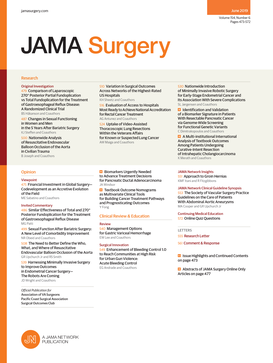A Predictive Tool for Ability to Remain at Home After Cancer Surgery in Older Adults.
IF 14.9
1区 医学
Q1 SURGERY
引用次数: 0
Abstract
Importance Shared decision-making with older adults regarding cancer surgery is critical. Prognostication tools that report individualized risk estimates of patient-centered outcomes can facilitate discussions. Objective To develop and internally validate a risk prediction model, STAYHOME, to estimate the risk of losing the ability to live at home for older adults after cancer surgery. Design, Setting, and Participants This was a retrospective population-based prognostic study conducted in Ontario, Canada. Included were adults 70 years and older undergoing cancer surgery over the period 2007 to 2019. Data were analyzed from June 2023 to January 2024. Exposures Predictor variables selected among information available preoperatively. The predictive model included age, sex, rural residence, previous cancer diagnosis, type of surgery, frailty, preoperative home care use, neoadjuvant therapy, cancer site, and cancer stage. Main Outcomes and Measures Inability to stay at home, defined as admission to nursing home. Fine-Gray models accounting for the competing risk of death were used. Discrimination and calibration were assessed. Bootstrap validation using 1000 samples with replacement was performed. Results Among 97 353 patients (median [IQR] age, 76 [73-81] years; 61 370 female [63.0%]), there were 2658 events (2.7%) at 6 months and 3746 events (3.8%) events at 12 months. The mean predicted risk of not staying home was 2.4% at 6 months and 3.4% at 12 months. Areas under the curve were 0.76 and 0.75 for 6-and 12-month predictions, respectively. Deviation from the observed risk of not staying home was 0.33% (95% CI, 0.31%-0.34%) for 6-month predictions and 0.46% (95% CI, 0.44%-0.48%) for 12-month predictions. Calibration was maintained across risk deciles. Conclusions and Relevance Results of this prognostic study reveal that STAYHOME used information available preoperatively to predict the risk of not remaining home after cancer surgery for older adults. It presented good discrimination and was well calibrated. Individualized risk estimates from STAYHOME may support counseling, shared decision-making, and setting of expectations before surgery.老年人癌症手术后居家生活能力的预测工具。
与老年人就癌症手术共同决策是至关重要的。预测工具报告以患者为中心的结果的个体化风险评估,可以促进讨论。目的建立并内部验证STAYHOME风险预测模型,以评估老年人癌症手术后失去在家生活能力的风险。设计、环境和参与者这是一项在加拿大安大略省进行的基于人群的回顾性预后研究。其中包括2007年至2019年期间接受癌症手术的70岁及以上的成年人。数据分析时间为2023年6月至2024年1月。在术前可用的信息中选择的ExposuresPredictor变量。预测模型包括年龄、性别、农村居住地、既往癌症诊断、手术类型、虚弱程度、术前家庭护理使用情况、新辅助治疗、肿瘤部位和癌症分期。主要结果和测量:不能呆在家里,定义为入住养老院。采用细灰色模型计算竞争死亡风险。对鉴别和校准进行评估。使用1000个带有替换的样本进行Bootstrap验证。结果97例 353例患者(中位[IQR]年龄为76[73-81]岁;61 370例女性[63.0%]),6个月时2658例(2.7%),12个月时3746例(3.8%)。6个月时不在家的平均预测风险为2.4%,12个月时为3.4%。6个月和12个月预测的曲线下面积分别为0.76和0.75。6个月预测与观察到的不待在家里的风险偏差为0.33% (95% CI, 0.31%-0.34%), 12个月预测偏差为0.46% (95% CI, 0.44%-0.48%)。在风险十分位数之间保持校准。结论和相关性这项预后研究的结果显示,STAYHOME使用术前可获得的信息来预测老年人癌症手术后不留在家中的风险。它具有良好的判别性和校准性。来自STAYHOME的个性化风险评估可以支持咨询、共同决策和在手术前设定预期。
本文章由计算机程序翻译,如有差异,请以英文原文为准。
求助全文
约1分钟内获得全文
求助全文
来源期刊

JAMA surgery
SURGERY-
CiteScore
20.80
自引率
3.60%
发文量
400
期刊介绍:
JAMA Surgery, an international peer-reviewed journal established in 1920, is the official publication of the Association of VA Surgeons, the Pacific Coast Surgical Association, and the Surgical Outcomes Club.It is a proud member of the JAMA Network, a consortium of peer-reviewed general medical and specialty publications.
 求助内容:
求助内容: 应助结果提醒方式:
应助结果提醒方式:


